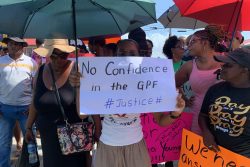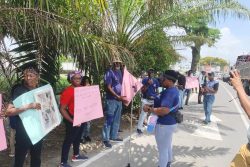NASSAU, (Reuters) – Powerful Hurricane Joaquin, which battered the Bahamas with torrential rain, powerful winds and storm surges today is now seen as less likely to pose a major threat to the U.S. East Coast, the U.S. National Hurricane Center said.
As U.S. officials raced to prepare for possible landfall early next week, three years after Superstorm Sandy devastated New York and New Jersey, the NHC said in a regular storm update:
“We are becoming optimistic that the Carolinas and the mid-Atlantic states will avoid the direct effects from Joaquin.”
Despite the more favorable forecast, the NHC said it could not rule out a direct impact on the East Coast, and the governors of New York, Connecticut and New Jersey – where Sandy killed more than 120 people and caused some $70 billion of property damage – warned residents to prepare for a possible severe storm.
 The Miami-based NHC said the hurricane, a Category 4 storm on a scale of 1 to 5, was churning slowly through the Bahamas.
The Miami-based NHC said the hurricane, a Category 4 storm on a scale of 1 to 5, was churning slowly through the Bahamas.
“A strong majority of forecast models is now in agreement on a track farther away from the United States East Coast,” the NHC said.
Joaquin, the third hurricane of the 2015 Atlantic season, was about 75 miles (120 km) south of San Salvador, Bahamas, with maximum sustained winds of 130 miles per hour (210 kph), the NHC said its advisory late on Thursday.
U.S. energy installations in the Gulf of Mexico were not affected.
Joaquin was the first major tropical cyclone to potentially threaten the U.S. northeast since Sandy hit in October 2012.
Earlier, several computer models had shown it approaching the coast of the Carolinas by the weekend, then losing strength as it moved offshore past Delaware and New Jersey early next week to head toward Long Island and New England.
In Washington, the White House said President Barack Obama had received updates from Homeland Security and emergency management officials about preparations for the hurricane.
“This is obviously something that the president and his team are closely monitoring here and I anticipate we’ll be doing that through the weekend,” White House spokesman Josh Earnest told reporters.
The governors of New Jersey, Virginia, North Carolina, South Carolina and Maryland all declared states of emergency and announced various measures, including the mobilization of National Guard troops, in preparation for the storm .
“We’re hoping for the best, but hope is not preparation nor is it a plan,” North Carolina Governor Pat McCrory said in a statement.
There were no immediate reports of deaths or injuries from the Bahamas but some additional strengthening of slow-moving Joaquin was possible as it churned over part of the central Bahamas on Thursday night and near or over portions of the northwest Bahamas on Friday, the NHC said.
At 8 p.m. EDT (midnight GMT), it said the storm was moving west-southwest at five miles (9 km) per hour.
Joaquin’s hurricane-force winds, which extended 50 miles (80 km) from its center, were forecast to miss the larger Bahamas islands and the main cities and cruise ship ports of Freeport and Nassau.
Storm surges will push water as high as 5 to 10 feet (1.5 to 3 meters) above normal tide levels in the central Bahamas, the NHC said, with up to 20 inches (51 cm) of rain possible in some areas.
Residents on the Bahamas islands closest to Joaquin’s path, including Rum Cay, Long Island, Exuma and Eleuthera, had stocked up on food and drink, and boarded up homes and businesses.
In North Carolina’s vulnerable Outer Banks, a strip of barrier islands linked by road, some vacationers decided to pack up early and leave before the weekend.
“Everybody is taking this one a little more seriously because of the rain we have had,” said Hyde County commissioner John Fletcher on Ocracoke Island, noting heavy rain had saturated the area in recent days.
A mandatory evacuation order was later issued for Ocracoke. More than 2,000 people were potentially affected by the order to abandon the popular beach destination, where English pirate Blackbeard was killed in the 1700s.
“Anyone who chooses to stay on Ocracoke for Hurricane Joaquin does so at their own risk,” a statement from local officials said.
U.S. energy companies said they had used the time since Sandy to gird their oil, natural gas and power infrastructure to better withstand another storm.
Consolidated Edison Inc, which supplies power, gas and steam to more than three million customers in the New York City area, said it was three years into a four-year, $2 billion plan to strengthen its infrastructure after Sandy shut down the Big Apple.
Sandy, the worst storm in Con Edison’s history, left about a million customers without power, with outages lasting a couple of weeks in the hardest hit areas. Some customers of other utilities were without power for much longer.
The U.S. East Coast has nine refineries with an operable capacity of about 1.3 million barrels per day, according to government data.









